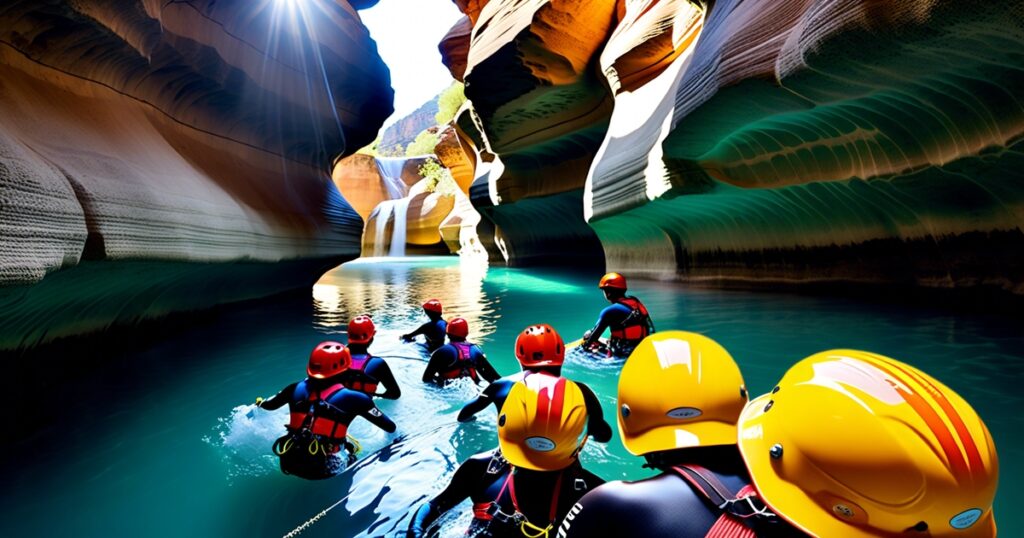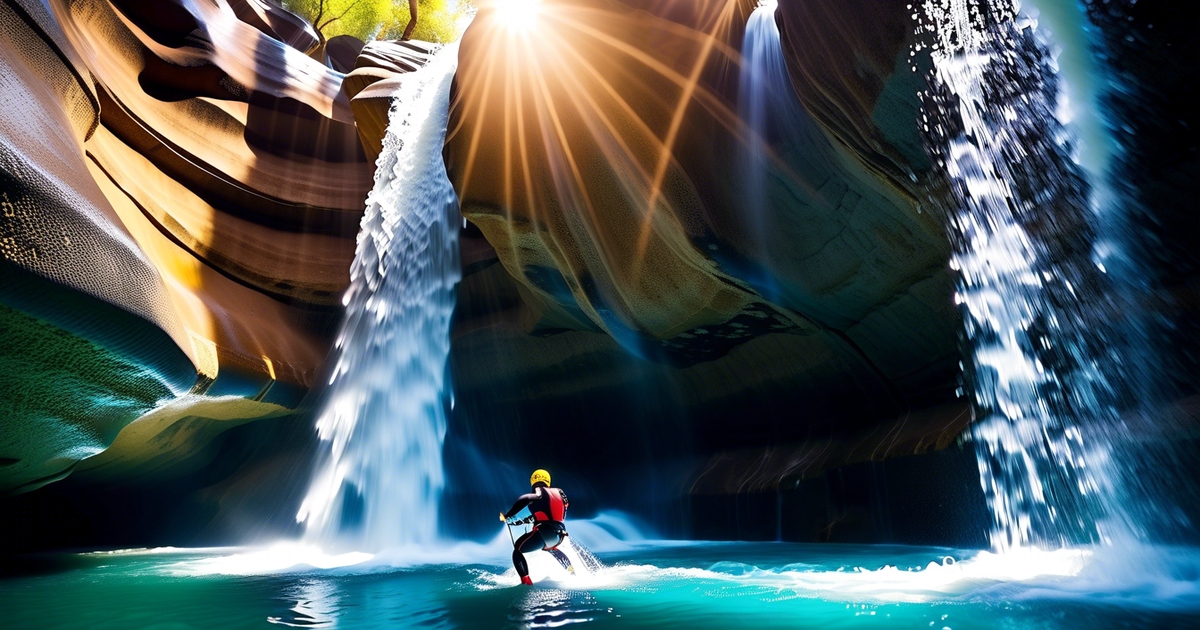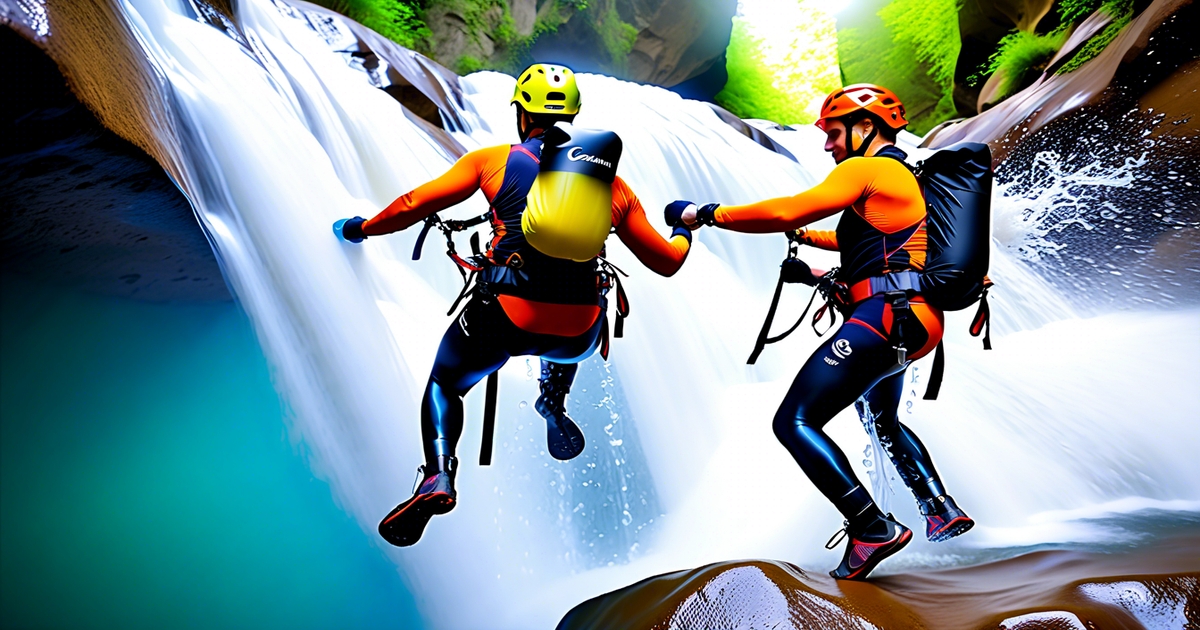Discover the exhilarating world of canyoning and canyoneering, where rugged landscapes meet adrenaline-pumping adventures. While both sports involve navigating canyons, they offer distinct experiences: canyoning combines hiking, climbing, and rappelling through water-filled gorges, while canyoneering emphasizes technical descents using various skills like rope work and route finding. Whether you seek the rush of cascading waterfalls or the challenge of steep cliffs, these activities cater to thrill-seekers and nature enthusiasts alike. Get ready to explore hidden gems, conquer natural obstacles, and immerse yourself in breathtaking surroundings as you push your limits in this ultimate outdoor pursuit.
Key Takeaways
- Canyoning and canyoneering are terms often used interchangeably, but canyoning typically refers to the European version involving various activities like jumping, abseiling, and swimming, while canyoneering is more commonly used in North America.
- There are different types of canyons such as slot canyons, box canyons, and river canyons, each offering unique challenges and experiences for enthusiasts.
- Wet canyons involve water obstacles like pools, waterfalls, and flowing streams, requiring specific skills and equipment for safe navigation by canyoneers who use them.
- Dry canyons, on the other hand, present challenges such as loose rocks, steep descents, and limited water sources, demanding a different set of techniques and gear.
- Understanding key hazards like flash floods, hypothermia, and rockfall is crucial for safe canyoning or canyoneering adventures.
- To prepare for varying water flow conditions in canyons, check weather forecasts, monitor local water levels, and be ready to adjust your plans accordingly.
Canyoning vs Canyoneering
Terminology
Canyoning and canyoneering are often used interchangeably, but there is a subtle difference in their terminology. Canyoning is primarily the term used in Europe, while canyoneering is more commonly used in the United States. Despite this distinction, both activities involve descending narrow gorges by various means.
Cultural Preferences
The choice of terminology between canyoning and canyoneering is influenced by cultural preferences. In Europe, where the activity originated, canyoning is the preferred term due to its historical roots in the region. On the other hand, canyoneering gained popularity in the U.S., reflecting the American outdoor culture and adventure sports scene.
International Recognition
Canyoning enjoys significant international recognition as a thrilling outdoor adventure sport. It has gained popularity worldwide for its unique blend of exploration, physical challenge, and natural beauty. Countries like Switzerland, France, Spain, and New Zealand are renowned for their diverse and breathtaking canyoning routes.
Exploring Canyon Types
Dry Canyons
Dry canyons are typically found in arid regions with minimal water flow. These canyons are characterized by their lack of running water, resulting in dry rock surfaces and minimal vegetation. The absence of water in dry canyons creates a unique landscape that is ideal for exploring without the need for specialized gear.
Dry canyons present a different set of challenges compared to wet canyons. In these canyons, canyoners face obstacles such as loose rocks, limited grip on dry surfaces, and extreme temperatures due to direct exposure to the sun. Navigating through dry canyons requires a different skill set, focusing more on climbing techniques and agility rather than swimming or rappelling.
Wet Canyons
Wet canyons, on the other hand, are characterized by flowing water, lush vegetation, and slippery surfaces. These canyons pose challenges related to water currents, submerged obstacles, and the constant presence of moisture. Technical moves in wet canyons often involve swimming through pools of water, rappelling down waterfalls, and maneuvering around slippery rocks.
Technical moves in dry canyons require advanced rock climbing techniques due to the nature of the terrain. Canyoneers must be proficient in using climbing equipment such as harnesses, ropes, and carabiners to navigate steep rock faces and cliffs. Unlike wet canyons where water assists in movement, dry canyons demand precise footwork and handholds to progress safely.
Grand Canyon Exploration
The Grand Canyon stands out as one of the most iconic and challenging canyon systems in the world. This main canyon offers a diverse range of experiences for canyoners, from basic canyon hiking trails to advanced technical routes requiring expert navigation skills. The Grand Canyon serves as a popular destination for both beginners and experienced canyoners seeking a mix of adventure and natural beauty.
- Dry Canyons:
- Ideal for exploration in arid regions
- Require climbing skills due to lack of water
- Wet Canyons:
- Characterized by flowing water and slippery surfaces
- Involve technical moves like rappelling down waterfalls
Diving into Wet Canyons
Running Water
Aquatic canyoning involves navigating through canyons with running water, adding an exciting element to the adventure. The presence of water in these canyons creates a dynamic environment for swimming, jumping, and sliding activities.
Wet canyons often feature stunning waterfalls and deep river pools, offering a unique experience for thrill-seekers. The sound of rushing water echoing off the canyon walls adds to the overall ambiance of the adventure.
Hazards in Wet Canyons
In aquatic canyoning, participants must be aware of potential hazards like hypothermia and drowning. The cold water in wet canyons can quickly lead to hypothermia, especially in cooler climates or during extended exposure.
The fast-flowing water in wet canyons poses a risk of drowning, emphasizing the importance of proper safety measures and techniques. Participants need to be skilled swimmers and equipped with knowledge on how to navigate through strong currents safely.
Specialized Clothing and Equipment
To mitigate risks in wet canyons, specialized clothing and equipment are essential. Commercial canyoning adventure trips typically provide wetsuits to maintain body temperature in cold water. Helmets are crucial for protecting against head injuries from falls or collisions with rocks.
Participants are also equipped with harnesses for climbing sections, sturdy footwear for traction on slippery surfaces, and ropes for rappelling down waterfalls. These tools enhance safety and ensure a more enjoyable canyoning experience in wet environments.
Navigating Dry Canyons
Unique Features
Dry canyons, especially in desert regions, offer a starkly different experience compared to wet canyons. The lack of flowing water creates unique landscapes characterized by towering walls, sculpted rock formations, and deep potholes carved out by ancient currents. These potholes, also known as tinajas, are natural reservoirs that collect rainwater, providing essential hydration for wildlife and serving as fascinating geological features for canyoneers.
Suitability for Beginners
Dry canyons are often considered more accessible for beginners due to the absence of swift water currents. This makes them ideal for individuals looking to explore canyoning without the added challenge of navigating through rushing streams or pools. The dry terrain allows newcomers to focus on honing their skills in rappelling, scrambling over rocks, and maneuvering through narrow passageways without the complexity of water hazards.
Challenging Technical Moves
Despite being beginner-friendly, dry canyons present their own set of challenges, particularly in terms of technical moves required to navigate the terrain successfully. Canyoneers must be adept at executing precise downclimbs, stemming techniques, and partner-assisted maneuvers to descend safely through rugged landscapes. The absence of water may lead to increased exposure to heights and reliance on solid anchor points for rappelling, adding an element of technical difficulty to the adventure.
Understanding Key Hazards
Hazards
Canyoning involves several hazards that can pose risks to participants. One of the primary dangers is flash floods, which can occur suddenly and without warning in narrow canyon environments. These floods can be triggered by heavy rainfall upstream, leading to a rapid increase in water levels that can trap or sweep away individuals.
Another significant hazard in canyoning is rockfall, where loose rocks or boulders may dislodge and fall from the canyon walls. This risk is heightened in areas with unstable geological formations or during periods of intense weather conditions. Participants must remain vigilant and wear appropriate protective gear to minimize the impact of potential rockfall incidents.
Assessing Obstacles
When engaging in canyoning activities, it is crucial to assess obstacles such as waterfalls, pools, and narrow passages within the canyon. Waterfalls can present challenges due to strong currents and slippery surfaces, requiring careful navigation techniques to descend safely. Pools of water may conceal hidden hazards or submerged obstacles, emphasizing the need for cautious exploration.
Moreover, narrow passages in canyons can restrict movement and visibility, increasing the risk of entrapment or injury. Participants must evaluate these obstacles beforehand and choose routes that align with their skill level and experience. Understanding the terrain and canyoning ratings can help individuals make informed decisions about their safety during the adventure.
Safety Measures
To mitigate risks associated with canyoning, participants should prioritize safety measures such as wearing helmets, life jackets, and appropriate footwear. Helmets provide protection against head injuries from falling rocks or accidental collisions, while life jackets offer buoyancy in water-filled sections of the canyon.
Furthermore, using proper footwear with good traction can prevent slips and falls on wet or uneven surfaces. It is essential to establish clear communication within the group, adhere to designated safety protocols, and carry essential rescue equipment such as ropes and first aid kits. By practicing caution, maintaining situational awareness, and following established safety guidelines, individuals can enjoy the thrill of canyoning while minimizing potential hazards.
Preparing for Water Flow
Essential Equipment
Wetsuits and gloves are crucial when navigating horizontal water movements in canyoning. These items provide insulation and protection against cold water temperatures and rough surfaces.
Wetsuits help maintain body heat, while gloves offer grip and shield hands from abrasions. Properly fitting gear is essential to ensure comfort and safety during water canyons.
Specialized Training
Specialized training is vital for handling the challenges posed by varying water flow intensities. Canyoneers must learn techniques to manage swift currents, eddies, and hydraulics effectively.
Training programs cover skills such as reading water features, understanding current dynamics, and executing maneuvers like slides and jumps. Practicing in controlled environments enhances proficiency in negotiating water movements.
Avoiding Flash Floods
Recognizing Risks
Canyoning and canyoneering expose participants to the dangers of flash floods. These sudden and powerful surges of water can occur without warning in narrow canyon environments. The risk of exposure to flash floods is heightened due to the confined spaces and limited escape routes within canyons.
Flash floods can be triggered by heavy rainfall upstream, even if it’s not raining in the immediate area where you are canyoning. This makes it crucial to recognize the signs of impending flash floods, such as a sudden increase in water level, changes in water color indicating debris, or distant thunder indicating a storm approaching.
Safety Precautions
To avoid getting caught in a flash flood while canyoning, it’s essential to stay vigilant and constantly assess your surroundings. Plan your canyoning trips during dry seasons when the risk of flash floods is lower. Always check weather forecasts before heading out and be prepared to cancel or postpone your trip if there’s a chance of heavy rainfall.
When inside a canyon, keep an eye out for higher ground where you can seek refuge in case of a flash flood. Using ropes and harnesses can help you navigate challenging terrain and potentially escape dangerous situations. Establish clear communication with your group members and have an emergency plan in place in case a flash flood occurs.
Monitoring Weather Conditions
One of the most effective ways to prevent encountering flash floods while canyoning is by closely monitoring weather conditions. Before embarking on your adventure, check multiple weather sources to ensure accurate information. Be aware that even light rain far away from your location can lead to a sudden rise in water levels downstream.
Always prioritize safety over excitement when it comes to canyoning. If there’s any doubt about the weather conditions or the possibility of flash floods, it’s best to postpone your trip. Remember that nature is unpredictable, and it’s better to err on the side of caution when dealing with the powerful forces of water in canyon environments.
Preventing Hypothermia
Proper Attire
When canyoning, hypothermia poses a significant risk in wet canyons. To prevent this, wearing appropriate clothing is crucial. Canyoneers should opt for quick-drying materials to avoid prolonged exposure to moisture.
Insulation Layer
Layering is key to regulating body temperature in canyoning. Wearing multiple layers allows canyoneers to adjust their attire based on the external conditions. Synthetic fabrics are ideal for insulation as they retain heat even when wet.
Importance of Gear
Investing in quality gear is essential for preventing hypothermia during canyoning. Wetsuits provide insulation and protect against cold water, while neoprene socks and gloves help retain warmth in extremities.
Stay Hydrated
Dehydration can exacerbate the risk of hypothermia. Canyoneers must stay hydrated throughout their adventure to maintain optimal body temperature. Carrying a hydration pack ensures easy access to water during the excursion.
Emergency Supplies
In case of unexpected circumstances, having emergency supplies can be a lifesaver. Packing items such as an emergency blanket, fire starter, and high-energy snacks can provide vital support if hypothermia sets in or other emergencies arise.
Body Movement
Encouraging continuous movement helps generate heat and prevent hypothermia. Canyoneers should engage in activities that keep their bodies active, such as climbing, swimming, or hiking between canyon sections.
Group Awareness
Maintaining awareness within the group is crucial for preventing hypothermia. Regular check-ins among members ensure everyone is adequately clothed and not exhibiting signs of hypothermia.
Environmental Factors
Understanding environmental factors is key to avoiding hypothermia risks. Monitoring weather forecasts before embarking on a canyoning trip helps prepare for potential temperature drops or adverse conditions.
Protecting Against Rockfall
Awareness and Preparation
When canyoning or canyoneering, the risk of rockfall is a significant concern. Be mindful of loose rocks dislodged by climbers above you. Always wear a helmet to protect your head from falling debris.
Safe Route Selection
To minimize the risk of rockfall incidents, choose your route wisely. Opt for paths with stable rock formations and avoid areas prone to loose rocks. Inspect the terrain ahead and listen for any signs of falling rocks.
Equipment and Techniques
- Secure Anchors: When rappelling or climbing, ensure anchors are placed in solid rock to prevent dislodgement.
- Helmet Usage: Always wear a sturdy helmet designed for climbing activities to safeguard against head injuries.
Emergency Preparedness
In case of a rockfall incident, take immediate action to protect yourself and your group. Seek shelter behind large boulders or in alcoves until the danger passes. Maintain clear communication with your team to coordinate a safe response.
Closing Thoughts
You’ve now grasped the distinctions between canyoning and canyoneering, explored various canyon types, and delved into the hazards and precautions associated with these thrilling activities. Remember, understanding the environment and being prepared are key to ensuring a safe and enjoyable experience. By preparing adequately for water flow, flash floods, hypothermia, and rockfall, you equip yourself with the knowledge to mitigate risks effectively. Stay vigilant, plan meticulously, and always prioritize safety above all else.
Now that you’re equipped with essential insights into canyoning and canyoneering, it’s time to put your knowledge into action. Get out there, explore stunning canyons, but do so responsibly. Share your experiences with fellow enthusiasts, continue learning about best practices, and above all, stay safe while immersing yourself in the beauty of these natural wonders.
Frequently Asked Questions
Canyoning vs Canyoneering
Canyoning and canyoneering are used interchangeably in North America, referring to the same activity of exploring canyons using a variety of techniques like rappelling, swimming, and hiking.
Exploring Canyon Types
What are the different types of canyons for exploration?
Canyons vary from slot canyons with narrow passages to box canyons enclosed by vertical walls, offering diverse experiences for adventurers.
Navigating Dry Canyons
How do you navigate dry canyons safely?
In dry canyons, hikers face challenges like loose rocks and limited water sources. Proper navigation skills, hydration, and sturdy footwear are crucial for a safe journey.
Preparing for Water Flow
How should one prepare for canyoning in flowing water?
For canyoning in wet canyons, essential gear includes wetsuits, helmets, and proper footwear to protect against cold water, slippery rocks, and potential hazards.
Preventing Hypothermia
What measures can be taken to prevent hypothermia during canyoning?
To prevent hypothermia in wet environments, wear appropriate clothing layers, stay dry as much as possible, and bring emergency blankets or heat packs for warmth.



